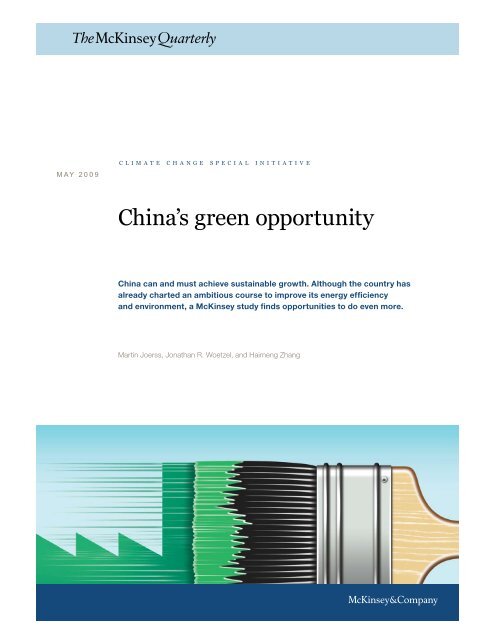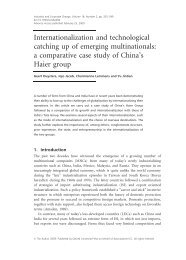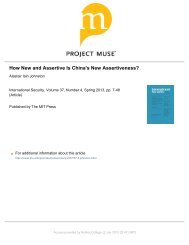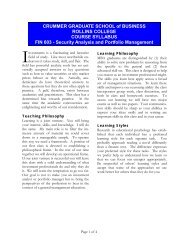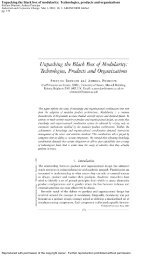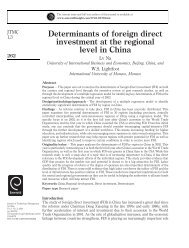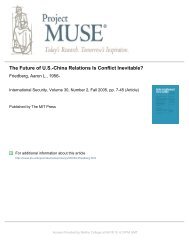China's green opportunity - McKinsey China
China's green opportunity - McKinsey China
China's green opportunity - McKinsey China
Create successful ePaper yourself
Turn your PDF publications into a flip-book with our unique Google optimized e-Paper software.
MAY 2009c l i m a t e c h a n g e s p e c i a l i n i t i a t i v e<strong>China</strong>’s <strong>green</strong> <strong>opportunity</strong><strong>China</strong> can and must achieve sustainable growth. Although the country hasalready charted an ambitious course to improve its energy efficiencyand environment, a <strong>McKinsey</strong> study finds opportunities to do even more.Martin Joerss, Jonathan R. Woetzel, and Haimeng Zhang
1<strong>China</strong>’s rapid development over the past three decades has lifted hundreds of millionsof people out of poverty and catapulted the country into the ranks of the world’s largesteconomies. Over the next several decades, as <strong>China</strong>’s economy continues to grow and the paceof urbanization accelerates, the country must not only ensure that it has sufficient and secureenergy resources but also mitigate the impact such growth will have on the environment.<strong>China</strong> must address these issues without compromising its growth or the living standards ofits people. But the population’s huge size and the scale of the economy have created a uniquelychallenging problem. To deal with it, <strong>China</strong>’s policy makers have developed an extensive bodyof regulations and policies to raise the energy efficiency of many sectors and thereby reducegrowth’s environmental consequences, including carbon emissions.To help policy makers and business leaders identify and prioritize additional opportunitiesto raise energy efficiency in <strong>China</strong> and make its growth more sustainable, we undertook astudy of technologies, measuring their impact on <strong>green</strong>house gas emissions. We looked only atapproaches that are technically feasible and likely to be commercially available no later than2030.Our findings indicate that by that year, the aggressive deployment of a range of new technologies—for instance, electric vehicles and new waste-management approaches—would allow <strong>China</strong> toreduce its demand for imported oil by an additional 30 to 40 percent over the energy efficiencygoals already identified. The country also could stabilize coal demand at current levels. Thisapproach would substantially improve <strong>China</strong>’s already significant plans to improve energysecurity and reduce carbon emissions. However, these goals will require considerable capitalinvestment. For the next two decades, <strong>China</strong> would need to spend €150 billion to €200 billion ayear—on top of currently planned spending on energy efficiency—to realize the full potential ofthe technologies. What’s more, several barriers stand in their way, including social costs (suchas layoffs) and retraining. And the window of <strong>opportunity</strong> for capturing benefits is short: everybuilding or power plant constructed without these technologies subtracts from the total energyefficiency gains they could deliver.Adopting them will require nothing less than a “<strong>green</strong> revolution” in the generation of power,the fueling of vehicles, the management of waste, the design of buildings and cities, and thenurturing of forests and agriculture. Policy makers will have to make the decisions, but to do sothey must understand the opportunities and trade-offs.The rising challenge of sustainability<strong>China</strong> is home to one-fifth of the world’s population. In 2007, the country consumed about2.7 billion tons 1 of standard coal equivalent 2 and emitted about 7.5 gigatons of <strong>green</strong>housegases. Indeed, it has overtaken the United States as the world’s top emitter. <strong>China</strong>’s demand forenergy—and the emissions and pollution associated with its use in industry, power generation,transport, and waste landfills—also contributes to other environmental ills. In northern <strong>China</strong>,desertification threatens arable land and grasslands. Water shortages are a growing problemacross the country.1 Metric tons: 1 metric ton = 2,205 pounds.2 One kilogram of standard coal equivalent = 7,000 kilocalories.
4it could reduce its dependence on imported oil by up to 30 percent more than the 30 percentreduction it currently hopes to achieve. The country could also stabilize coal demand at currentlevels, substantially reducing the proportion of electric power generated by using this fossilfuel, to 34 percent by 2030, down from 80 percent today. These efforts could enable <strong>China</strong> tohold its <strong>green</strong>house gas emissions to roughly eight gigatons by 2030—roughly 10 percent higherthan 2005 levels—without hindering growth.Q3 2009Green <strong>China</strong>This would amount to nothing less than a <strong>green</strong> revolution in <strong>China</strong>. Let’s look in detail at eachExhibit 2 of 3of the five categories of opportunities.Glance: Nuclear power, as well as hydro power and other renewable energy sources, couldcollectively replace coal as <strong>China</strong>’s primary sources of power.exhibit 2Exhibit 2Green powerin <strong>China</strong>Green power in <strong>China</strong>Power generation mix, %100% in terawatthours (TWh)2,5009,250 8,10034Coal658119Hydro8Gas1612 020 0 12005177802030policyscenario1612842030abatementscenario 2NuclearWindSolarOther 11 Includes geothermal, coal bed methane, landfill gas, municipal solid waste, and biomass.2 Figures do not sum to total, because of rounding.Source: Expert interviews; <strong>McKinsey</strong> analysisGreen powerAs manufacturers ramp up the production of equipment for solar and wind power, the costof implementing these technologies will decline. By 2030, <strong>China</strong> could generate 8 percent ofits energy through solar and 12 percent though wind (compared with nearly nothing in eachcategory today), and the proportion of electricity generated by nuclear power could rise to16 percent, from 2 percent; by hydropower to 19 percent, from 16 percent; and by natural gas to8 percent, from 1 percent (Exhibit 2).<strong>China</strong> is the world’s largest exporter of photovoltaic solar panels, and we think it will hold thatposition for some time. The cost of the equipment used in <strong>China</strong>’s photovoltaic solar-powerinstallations should fall almost 80 percent by 2030, given the country’s (and the world’s)
5projected photovoltaic capacity and this sector’s historical learning rate (cost reductions gainedthrough experience as production volumes rise). As the technology improves, solar-powergenerating costs will fall to €0.045 per kilowatt-hour in 2030, making it just 50 percent morecostly than coal rather than five times, as it is today.Similarly, <strong>China</strong> could have an installed nuclear capacity of 182 gigawatts by 2030, an increaseof 74 gigawatts over the policy scenario’s goal. <strong>China</strong> manufactures 70 percent of the equipmentnecessary for nuclear plants, and the cost for this equipment has been falling. If the countrydevelops nuclear power to the fullest extent, by 2030 carbon emissions could fall by 470 milliontons, at a cost of €3 per ton.By 2030, carbon capture and storage could abate 730 megatons of <strong>green</strong>house gas emissionsfrom <strong>China</strong>’s most important fuel source, coal, at a cost of over €60 a ton. This technology isvery expensive, but more than 25 percent of <strong>China</strong>’s coal-based power plants—both new andretrofitted—could be equipped with it by that year.Green transportCars and trucks are a relatively minor source of <strong>green</strong>house gas emissions in <strong>China</strong>, butthat’s about to change. By 2030, it could replace the United States as the nation with the mostvehicles—over 330 million of them. Let’s assume that internal-combustion engines have by thenbecome as fuel efficient as possible at a reasonable price. Still, <strong>China</strong> will have to rely on importsfor 75 percent of its oil.Our policy scenario estimates for energy efficiency from the adoption of electrified vehicles areconservative. Suppose, however, that <strong>China</strong> began to adopt them widely starting in 2015 andramped up the rate of adoption to 100 percent of new vehicles by 2020. Our analysis shows thatdemand for imported oil might fall 30 to 40 percent. <strong>China</strong> could emerge as a global leader inthis industry by leveraging the country’s low-cost labor supply, its fast-growing vehicle market,its success in rechargeable-battery technology, and its substantial investments (both made andcommitted) in R&D for electrified transport.From 2016 through 2030, capital investments of over €70 billion a year would be needed for anextensive rollout of electrified vehicles and for the recharging infrastructure <strong>China</strong> will need toaccommodate them.Green industryThe steel, chemical, cement, coal mining, and waste-management sectors play a crucial rolein <strong>China</strong>’s economic development. All of them also use significant amounts of energy: theyaccounted for about one-third of total consumption and 44 percent of carbon emissions in 2005and are also a major source of air and water pollution. <strong>China</strong> is shutting down or consolidatingsubscale, inefficient facilities in each of these sectors, has set energy-reduction targets fortheir largest enterprises, and is adopting global best practices in production. These and othergovernment energy-saving efforts in the industrial sector could save 450 million tons ofstandard coal equivalent a year by 2030.New quality standards for cement, introduced in 2008, set higher specifications for clinker (theprimary material in it) and stricter definitions for clinker substitute. We expect such measures
6to cut the use of cement in concrete by 10 percent, cutting the cement industry’s emissionsproportionately. Similarly, <strong>China</strong> is setting standards to reduce the energy used in burning wasteand in recovering and reusing coal-bed methane—standards that would reduce the emissionsfrom those activities. Such policy scenario efforts would allow <strong>China</strong> to reduce emissions inthese sectors to 4.8 gigatons by 2030.<strong>China</strong> has ample <strong>opportunity</strong> to reduce each segment’s emissions below those envisioned in thepolicy scenario: new technologies and process improvements could abate an additional 1.6 gigatonsof <strong>green</strong>house gas emissions. The cement industry, for instance, could use agriculturalwaste as an alternative fuel for co-firing with coal in kilns. In steel making, thin-strip directcasting (casting and rolling in a single step) could substantially reduce energy use and emissions.The challenges of implementing new technologies include limited talent and funds forinvestment. The skilled technicians and engineers needed are scarce in <strong>China</strong>, and becauseits universities don’t teach some of the required skills (such as systems engineering), theselimitations will persist. In certain sectors, the <strong>opportunity</strong> cost of investment in energy efficiencyis high; in others, the total returns seem too low. Executives also dislike the idea of shuttingdown plants to improve them or of accepting the losses associated with introducing noveltechnologies or processes. To pursue the additional efficiency and abatement opportunities, thegovernment will have to address these hurdles.Green buildings<strong>China</strong>’s rapid urbanization will continue for several decades. Apartment houses, office buildings,and commercial centers are proliferating to accommodate this massive migration and economicdevelopment. In the frozen-technology scenario, total emissions from energy consumption in thebuildings sector will rise from 1.1 gigatons of <strong>green</strong>house gases in 2005 to 5.1 gigatons by 2030.Policy scenario moves to address the growth of the sector’s energy use and emissions couldreduce them to 3.2 gigatons by 2030. We estimate that implementing the full range of practicaltechnologies would cut emissions to 1.6 gigatons annually.Total floor space (including residential and commercial) will more than double in <strong>China</strong>, from42 billion square meters in 2005 to 91 billion in 2030. Rising income levels are pushing upenergy use as households buy more appliances and air conditioners. To address these issues,the government is setting targets so that more heat for urban buildings comes from relativelyenergy-efficient sources, such as natural gas and combined heat and power plants, rather thancoal and diesel. Over time, natural gas will replace coal (or coal gas) for cooking and for heatingwater in many areas. The government is also imposing strict new energy-efficiency rules forbuilding codes, enforcing firm energy-efficiency ratings for appliances, and rolling out subsidiesto encourage the shift to more efficient lighting.Beyond these government-directed efforts, the opportunities include replacing low-efficiencycommunity boiler systems in northern <strong>China</strong> with large network district-heating systems 6and retrofitting commercial buildings with automated systems and pumps to regulate heating,ventilation, and air conditioning more efficiently. <strong>China</strong> can also apply to new buildings theprinciples of “passive design”: reducing the energy used for heating and cooling by designing6Coal plants that heat water and channel it to buildings.
8Related articles“What countries cando about cuttingcarbon emissions”“How the worldshould invest inenergy efficiency”“Promoting energyefficiency in thedeveloping world”“Connecting climatechange and economicrecovery”“Meeting thechallenges of <strong>China</strong>’sgrowing cities”“Cleaner energy for<strong>China</strong>: An interviewwith the chairman ofENN Group”and promoting agricultural practices such as conservation tillage and the use of the latestfertilizers. These opportunities could also have knock-on effects: improved land-managementpractices, for example, control desertification and use water supplies more productively.To realize the full potential of the additional opportunities, <strong>China</strong> would need to start now;even waiting a few years would reduce the possibilities for raising energy efficiency and abatingemissions. To capture the full abatement potential in the power-generation sector, for instance,<strong>China</strong> must start implementing by 2010 most of the measures we recommend. <strong>China</strong> builds newplants continually. Coal-fired ones brought on line next year, if not retrofitted with expensivecarbon-capture technologies, will emit <strong>green</strong>house gases for the next 30 to 40 years. A simplesensitivity analysis shows that postponing the implementation of cleaner power technologies forjust five years would cut the abatement potential by up to 1.5 gigatons of <strong>green</strong>house gases—over50 percent of what’s possible (Exhibit 3). A ten-year delay would reduce the abatement potentialby 80 percent.By starting now to embrace the technologies for a <strong>green</strong> revolution, <strong>China</strong> can create a futurewith greater energy security and lower energy emissions—without compromising economicgrowth and the living standards of its people.QMartin Joerss is a principal in <strong>McKinsey</strong>’s Beijing office; Jonathan Woetzel is a director in the Shanghai office,where Haimeng Zhang is an associate principal. Copyright © 2009 <strong>McKinsey</strong> & Company.All rights reserved.


